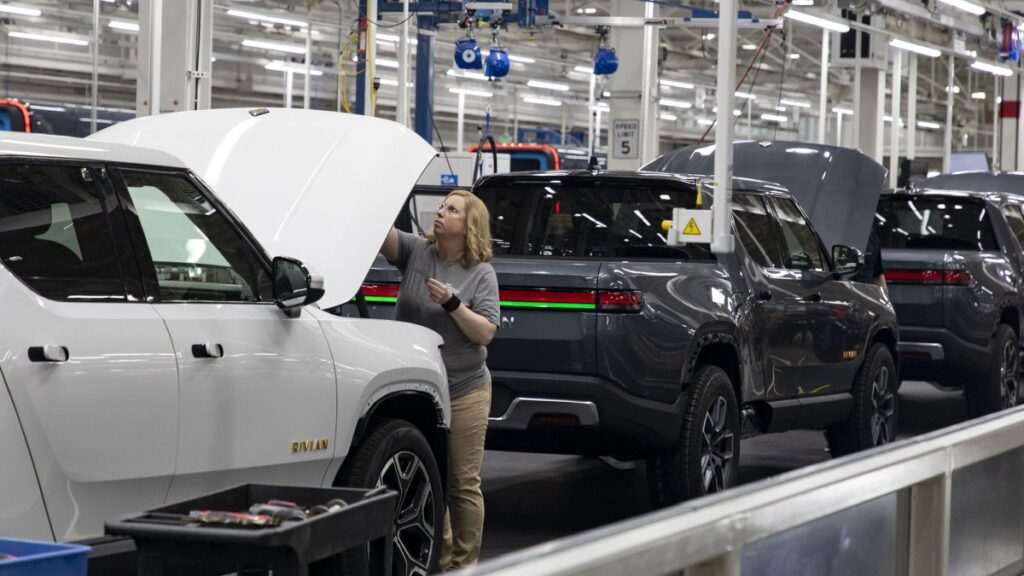Rivian aims for profit by simplifying output and cutting costs

NORMAL, Illinois — Electric-vehicle maker Rivian’s drive to cut costs and turn its first profit has removed over 100 steps from the battery-making process, 52 pieces of equipment from the body shop and over 500 parts from the design of its flagship SUVs and pickups.
The result of Rivian retooling its manufacturing process is a 35% reduction in cost of materials for vans and savings of “similar magnitude” for its other lines, CEO RJ Scaringe told Reuters.
Rivian’s overall cost of building its EVs has “improved dramatically,” he told Reuters during a factory tour Friday at Normal, Illinois, 130 miles (209 km) south of Chicago. “The design of the parts and the design of the plant facilitate making the vehicle easier to build.”
Reuters got an exclusive look inside Rivian’s four-million-square-foot factory, with investors eager to learn more about the size and pace of savings after a three-week shutdown in April.
Cutting cost is critical for Rivian and other EV startups as high interest rates have turned some potential customers off EVs that are typically more expensive to buy than their gasoline-powered counterparts. Rivian has never turned a quarterly net profit since it was founded in 2009 and lost $1.5 billion in the first quarter.
“We did a similar process of really going through and redesigning a number of components for cost, so we took over 35% of the material cost out of the vans,” Scaringe said, referring to a January shutdown of the van line.
Built primarily for major shareholder Amazon, Rivian’s vans account for about one-fifth of its revenue.
Market leader Tesla has slashed prices but some smaller EV makers, including Fisker, have filed for bankruptcy.
Rivian is on more solid ground financially, but loses nearly $39,000 on every vehicle and is banking on cost savings to help it turn a gross profit this year.
WORK SMARTER
In addition to simplified assembly and less equipment at the plant, changes flow into the second generation of Rivian’s R1 vehicles with company-built drive units, upgraded software and new battery packs.
Making those battery packs is now easier. The modules are redesigned and come in one piece instead of walls and floors that were built separately.
The vehicles also come with a new architecture meant to reduce weight and improve manufacturing efficiency, including shedding 1.6 miles of wiring from each vehicle.
Those changes have reduced labor time and pushed the rate of assembly on the manufacturing line up about 30%.
“All of that together leads to us being able to get to our path to profitability and be gross-margin positive,” said Tim Fallon, vice president of manufacturing at the plant.
But investors are worried. The plant shutdown meant Rivian is targeting production of 57,000 vehicles – almost the same as last year – and shares in the company have halved this year.
Cash and short-term investments fell by about $1.5 billion in the first quarter to just under $8 billion. Rivian had said it has enough capital to launch the less expensive and smaller R2 SUVs in early 2026.
Sam Fiorani, vice president at research firm AutoForecast Solutions, who had expected the company to require a cash infusion before summer 2025, said reducing the cost per vehicle gives Rivian breathing room.
“Focusing on where the cost savings are is extremely important to the longevity of the company and to calming the fears of any investors,” he said.
To hasten R2 deliveries, Rivian said in March it would start producing its $45,000 five-seat SUV in its Illinois plant, which will be expanded, instead of at a planned $5-billion plant in Georgia. The move will save $2 billion.
R2 will account for 155,000 vehicles per year of the increased capacity of 215,000 in Normal, Fallon said. The factory currently has capacity of 150,000 vehicles.
“We’ve really been able to understand what we need to do to continue to move forward and really be smarter about what we’re doing,” Fallon said.



